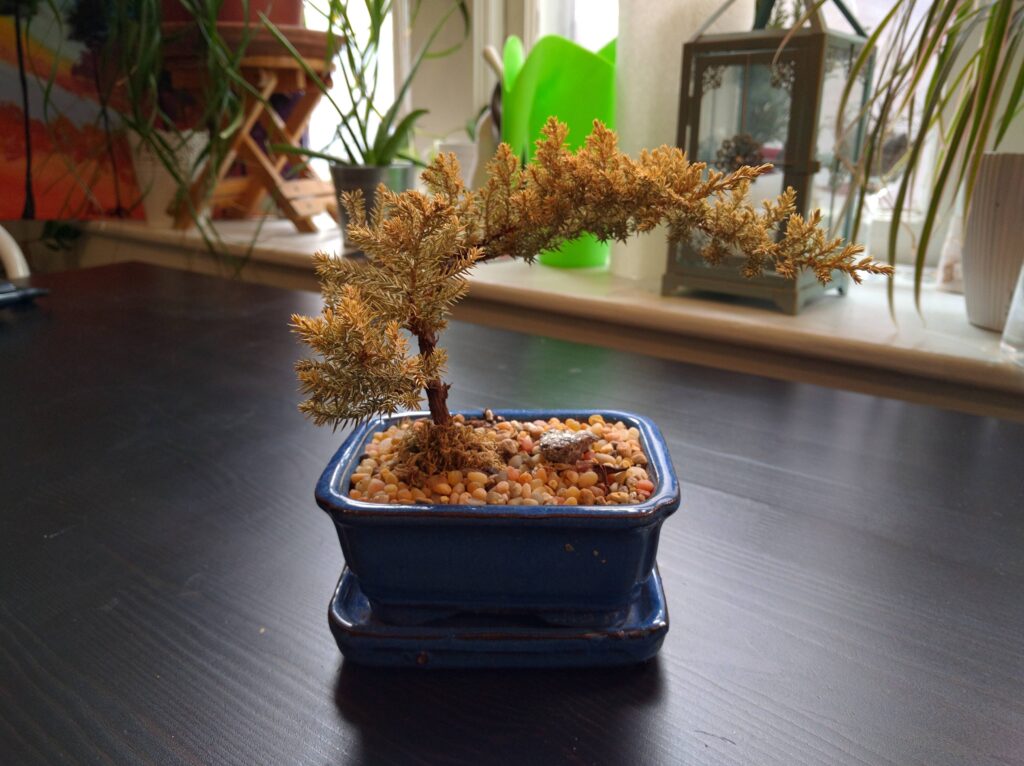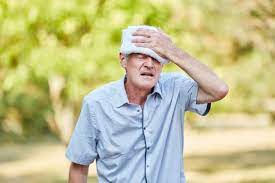
Out of sight is not out of mind. Ask how many killed 1 st tree. Why? Tell of your own experience using potting soil. Loved tree to death by overwatering. Will discuss soil, substrate, what’s the difference; qualities of substrates; organics and inorganics in substrate mix; physical properties of substrates; watering and chemical properties.
1) Soil (growing medium or substrate) is the most important part of growing healthy roots. (The secret sauce)
2) Field Soil. Dead or alive? Both – beneficial living organisms in the field soil feed on dead roots & other organic matter making it a living
organism.
3) Can we use field soil for our bonsai? No Why? Roots can’t get enough O2. Are 50% solids, 25% water, and 25% air when at maximum water holding capacity. When put in bonsai pot these % change because it compacts and constrains which reduces O2 available. Too much H2O and not enough O2 is why field soil can’t be used for container growing. No aeration or drainage. Can use clayish field soil for building perimeter of the slab because of no compaction in the pot.
4) Roots require O2. The substrate needs to have air space. Lack of air is the main cause of death of bonsai trees. Bonsai roots thrive in modern well-aerated substrate with adequate pore space.
5) What is the substrate? What do you use? Many varied recipes. The question is “What are the basic properties necessary for roots to
live in optimum conditions in a bonsai pot?
6) Substrate describes the physical soilless components in a container where the roots grow. It is the material that serves as a reservoir and as the source for root uptake of water and essential elements. It should drain well yet hold some water as well as keep the Ph and salts in a tolerable range.
7) Bonsai roots will adapt to almost any material that provides water, oxygen, and essential elements and is non-toxic to the plant. Repeat that. Any workable component meeting the roots cyclical needs of moisture, aeration, and essential elements will be an ideal substrate.
8) The following qualities of substrate allow the roots to function: Should be porous. O2 is the most important part. Roots grow into air spaces! Should not hinder air from drawing in from the top. Roots require a steady supply of O2 to continually exchange CO2 for O2. Roots require a substrate with a high water holding capacity.
1. Water is held in pores between particles and inside porous components.
2. Holes in the pot allow water to drain out along with anything that mixes with the water, such as fertilizers with the next watering. Roots require essential chemical elements (i.e. minerals) and photosynthate (carbohydrates/sugars). Photosynthates are the product of photosynthesis. Roots require a substrate with the capacity to store a reservoir of these essential elements until the roots can use them.
9) 4 factors that affect the air and water in a bonsai pot:
a) The substrate. Field soil has 50% pore space for O2 and H2O. The substrate has 70% porosity due to larger components.
b) The height and shape of the pot. Taller pots hold proportionally more air and less water than shallow pots with the same volume.
c) Handling of the substrate before and during potting.
d) Watering of the substrate after potting. Both too often and too\much watering influences O2 and H2O content even more than the substrate components.
Organic and Inorganic Materials
1) Organic – dead carbon-based forms. Properties: High water holding capacity and high nutrient-exchange capacity when used in substrate. They hold on to essential elements. Frequent watering without organic matter present will leach out of the pot. Attracts good bacteria, fungi, and nematodes. 99% of nematodes are beneficial.
2) Particle size & pore size determines drainage in a substrate. Larger = more aeration. Smaller = less aeration. A substrate of coarse-textured inorganic material mixed with coarse textured organic material combines to make larger secondary particles called aggregate. The aggregate mix is made up of larger-sized pore space for more drainage. If a substrate has more than 50% organic in it the pore space begins to decrease.
Organics used include:
Hammer milled Fir Bark, Pine Bark, Coconut Fiber, Oak Leaf Mold, Rice Hulls.
Properties are:
Excellent drainage
Can hold some essential elements
Is slow to decay
Retains water
Retains its original size under compression
Has the substantial amount of internal porosity
Is not harmful to the plant
Suppresses bad pathogenic fungi
Is long-lasting.
3) Inorganics – What are the functions of the inorganic components we choose to use as bonsai substrate? Is basically gravel except for perlite and pumice. Some have a low nutrient exchange capacity but provide good physical properties for the substrate. These components can help make up a large proportion of air pockets. Large-textured inorganics = + aeration – Water holding capacity. Inorganics used include calcinated clays, (Terra Green, Soil Master) pumice, lava rock, decomposed granite, akadama.
4) A mix of ½ commercial pine bark blended with ½ commercially expanded calcinated clay has been lab-tested over several years. Data from those tests confirm optimal percentage water-holding capacity, optimal total percentage pore spaces, and substrate consistency over time. Bonsai roots thrive in those substrate properties during both development and refined stages.
5) You can use one single material, or a mix of ingredients depending on how much you need to regulate the substrates’ water-holding capacity and nutrient-exchange capacity for a SPECIFIC PLANT and SPECIFIC CONDITIONS. Recipes should vary according to the species grown, temperature, moisture, pot size, and light intensity. The type of plant you have, your local microclimate and local sources of basic materials will determine what you end up using as a substrate. Roots respond to pore spaces, not products. Look at the properties of those products.
6) What can we learn from commercial container-grown nurseries that we can apply to grow bonsai? HEALTHY SUBSTRATE GROWS HEALTHY ROOTS AND HEALTHY ROOTS GROW HEALTHY PLANTS IN THAT ORDER. *Organic/Inorganic substrate mix amended with a synthetic
controlled released fertilizer (CRF) is the simplest, least expensive, and most successful system for optimum growth in pots.
Physical Properties
1. What are the optimal physical properties of a bonsai substrate? Two main concerns:
Roots grow in the right amount of pore space supplying O2 to roots (i.e. grain size, shape, and composition) and, It maintains adequate porosity over time (i.e. it doesn’t break down and retain too much water) It doesn’t compact. As the substrate particle size increases the water holding capacity decreases and the aeration capacity increases. Over time, there is settling, compaction, decomposition, and shrinkage resulting in lower porosity resulting in too little O2 and too much H2O. Why not use all gritty, coarse textured materials for bonsai substrate? You could, but you would be wasting water and fertilizer, and small microscopic roots can’t grow in overly large pore spaces. Plant health is compromised in either too small or too large pore space.
2. Why does the bottom wet zone of bonsai pot stay soaked, especially in shallow pots. All water does not automatically drain out. Mix in a shallow pot needs more air space than in a tall pot. Capillary (wicking) water doesn’t clog the pores because it sticks better to the substrate particles. Free water clogs pores and stays at the bottom of the pot. The bottom zone in the pot collects water and resists gravity’s effect of draining out the holes because the Hydrogen in water is bonding to the substrate. The perched water table, which is the zone of the fully wet substrate at the bottom of every potted plant, continues to hold water after each watering.
3. Drainage layer decreases root space increases standing water and works against drainage. (Book) Water is held at the bottom by surface tension, capillary action, and gravity. Then it is drawn upward against gravity to a higher level. 4. Water’s cohesion (holding water together) and adhesion (sticking to other things) keep it sticking and holding to the substrate in any bonsai pot. If the substrate mix is not homogenous throughout the entire pot the upper-layer requires full wetting before a different-textured lower layer gets any water.
5. Water saturation is a balance between capillary and gravity forces. Gravity causes the water to drain away while the capillary forces of adhesion, cohesion, and surface tension hold on to it.
6. Different-sized particle layers in a bonsai pot do more harm than good. A bottom layer of coarse gravel with large pore spaces creates an effective barrier to downward water movement. Water tends to move from an area of large pore size to an area of small pore size. Tilt Pot To Aid Drainage.
7. When to repot a tree. No need if the roots haven’t colonized the pot. We should repot when:
Desiccation
Lack of percolation
Change in the style/position of the tree
8. What happens to the roots of a pot-bound tree when trying to grow in a slow-draining substrate? The root system gets less healthy due to increased CO2, increased growth of fungi, and decreased pore space. = less O2.
9. Watering
Two ways aeration happens in a bonsai pot.
1. Hydraulic pumping. When we water we temporarily fill the pore space with water, displacing the gases in the pore spaces. As the water drains it pulls in air.
2. Diffusion. It’s what’s happening when we’re not watering. Gases in the pores exchange with the atmosphere.
Water when a plant needs water. What are the requirements of the tree? Use moisture and Ph meter. The needs of the plant change over time depending on humidity, season, temperature, size and shape of the pot, and other factors. Watering is a product of how many times watered times the amount of water. The two most important physical properties of a potting mix are Air Filled Porosity and Water Holding
Capacity. Air Filled Porosity (AFP) should be between 30-10%. 15-20% is preferred. Less than 10% are considered waterlogged. Water Holding Capacity (WHC) or Water Saturation (Sw) should have a “container capacity” of at least 30%.
Check for the WHC with this method:
A. Wait until the substrate is almost dried out and tape holes of the pot.
B. Slowly add water until the water starts to overflow.
C. Remove the tape and measure the amount of cc water drained with a measuring cup.
D. Calculate the volume of the pot by measuring the length X width X height in cc.
E. Divide cc’s of water by substrate cc volume.
F. Multiply the decimal by 100 to get the %porosity.
Air replaces the water that is collected. If it is less than 20% consider adding more coarse-textured gravel to your substrate next repotting.
Between waterings, the Sw will fall below container capacity due to evaporation and transpiration. How fast depends on the plant, soil, environmental conditions.
Chemical Properties
1. A microscopic-sized clay particle is covered with negative charges. A few positive-charged ions (cations) floating around in sticky water stick to those tiny particles.
2. When one cation enters a root hair, then another cation must exit. That replaced essential element is then transported up the plant by proteins.
3. Organic pine bark will hold on to those essential elements twenty times better than the inorganic gravel most commonly used in bonsai substrate.
4. Since so many soils mixes work, and since there is a very wide variety of rock and soil in North America, there is no need to import special soil mixes or ingredients from other countries.
5. Locally sourced materials are the most cost-effective and worthy components for growing your own bonsai.
Presentation by James Keith


